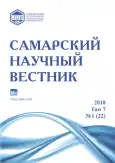Juglans L. genus trees influence on cellulolytic soil activity in Samara University Botanical Garden Dendrarium
- Authors: Pomogaybin E.A.1, Pomogaybin A.V.1
-
Affiliations:
- Samara National Research University
- Issue: Vol 7, No 1 (2018)
- Pages: 105-109
- Section: 03.02.00 – General Biology
- URL: https://journals.rcsi.science/2309-4370/article/view/25355
- DOI: https://doi.org/10.17816/snv201871120
- ID: 25355
Cite item
Full Text
Abstract
Woody plants change qualitatively and quantitatively the substances dynamics into the soil environment, acting on intercepting and saturating them with discharge from the leaves and material precipitated from the air. The arrival of the ground (leaf litter) and underground (root-slope) mort mass influences the chemical processes in the soil and its morphological structure changing. By forming and releasing litter, the trees indirectly activate the soil microflora. The nut plants, forming seeds rich in proteins and lipids, have been used by humans since ancient times as food, medicinal plants, a source of biologically active substances. The nuts ( Juglans ) introduction history in Samara University Botanical Garden begins from the moment of the garden creation. Our work presents the results of the evaluation of the cellulolytic activity of the soil under the walnut trees in Samara University Botanical Garden Dendrarium. The soil sampling were carried out in September 2011 in the sub-crown space for the trees of J. regia and J. nirga (for each species - old, middle age, young specimens), other Juglans species ( J. ailanthifolia, J. mandshurica, J. cinerea, J. сordiformis, J. microcarpa ) were also tested. The determination of cellulolytic activity was carried out by the application method in Petri dishes. Visual examination of exposed paper samples showed its sufficient safety in the control and strong destruction under the influence of the soil in variants J. regia (old tree), J. nirga (all variants), J. regia . A comparison of the results obtained with the data of 2009 showed that the cellulolytic activity of the soil varies from year to year, under the influence of weather conditions.
Full Text
##article.viewOnOriginalSite##About the authors
Efim Alexandrovich Pomogaybin
Samara National Research University
Email: rainstoker@rambler.ru
postgraduate student of Ecology, Botany and Nature Conservation Department
SamaraAlexander Vladimirovich Pomogaybin
Samara National Research University
Author for correspondence.
Email: rainstoker@rambler.ru
candidate of biological sciences, deputy director of the Botany Garden
Russian Federation, SamaraReferences
- Ayres E., Dromph K.M., Bardgett R.D. Do plant species encourage soil biota that specialise in the rapid decomposition of their litter? // Soil Biology & Biochemistry. 2006. Vol. 38. P. 183-186.
- Hättenschwiler S., Vitousek P.M. The role of polyphenols in terrestrial ecosystem nutrient cycling // Trends in Ecology & Evolution. 2000. Vol. 15. P. 238-243.
- Weber P., Bol R., Dixon L., Bardgett R.D. Large old trees influence patterns of delta C-13 and delta N-15 in forests // Rapid Communications in Mass Spectrometry. 2008. Vol. 22. P. 1627-1630.
- Rhoades C.C. Single-tree influences on soil properties in agroforestry: lessons from natural forests and savanna ecosystems // Agroforestry Systems. 1996. Vol. 35. № 1. P. 71-94.
- Гудвин Т., Мерсер Э. Введение в биохимию растений: В 2-х т. Т. 2. М.: Мир, 1986. 312 с.
- Частухин В.Я., Николаевская М.А. Биологический распад и ресинтез органических веществ в природе. Л.: Наука, 1969. 326 с.
- Колешко О.И. Экология микроорганизмов почвы: лабораторный практикум. Минск: Высш. школа, 1981. 176 с.
- Алексеев Ю.А., Жмылев П.В., Карпухина Е.А. Деревья и кустарники. М.: 1997. 592 с.
- Атлас растений. М.: ОЛМА-ПРЕСС Образование, 2005. 623 с.
- Баранов В.Д., Устименко Г.В. Мир культурных растений. М.: Мысль, 1994. 381 с.
- Prasad R.B.N. Walnuts and pecans // Encyclopedia of Food Sciences and Nutrition (Second Edition). Academic Press, 2003. P. 6071-6079.
- Берзегова А.А. Химический состав плодов ореха грецкого // Новые технологии. 2007. № 4. С. 28-29.
- Стрела Т.Е. Орех грецкий. К.: Наук. Думка, 1990. 192 с.
- Poon T., Baldwin N. Authorised EU health claim for walnuts // Foods, Nutrients and Food Ingredients with Authorised EU Health Claims, 2014. P. 329-348.
- Помогайбин А.В. Краткие итоги интродукции видов рода Juglans в Ботаническом саду Самарского госуниверситета // Самарская Лука: Бюллетень. 2007. Т. 16, № 1-2 (19-20). С. 110-114.
- Помогайбин А.В. Ритмы развития и зимостойкость орехов Самарского ботанического сада // Интродукция, акклиматизация, охрана и использование растений. Самара, 1991. С. 89-93.
- Розно С.А., Кавеленова Л.М. Итоги интродукции древесных растений в лесостепи Среднего Поволжья. Самара: Издательство «Самарский университет», 2007. 228 с.
- Помогайбин А.В. Эколого-биологический анализ результатов интродукционных испытаний видов рода орех (Juglans L.) в лесостепи Среднего Поволжья: автореф. дис. … канд. биол. наук. Тольятти, 2008. 16 с.
- Определение фитопатогенов в почве [Электронный ресурс] // http://dizayn-reya.narod.ru/3/3.htm.
- Микробиологический анализ почвы [Электронный ресурс] // Сибирский клуб любителей дачной жизни. - http://sib-sad.info.
Supplementary files










